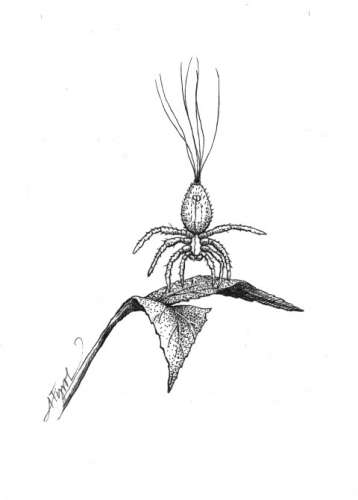
Even if we shun the leggy creatures that make them, we marvel at the geometric precision and dew-frosted beauty of spider webs. There is nothing so elegant, so versatile, and so perfectly suited to its function as a spider’s web. In early mornings at this time of year, there is a glint of webbing on the lawn, and hillsides are decorated with gossamer. There is magic in the scene.
How do spiders create these masterpieces? A spider produces silk from several different kinds of glands, with each gland responsible for its own protein chemistry. These glands are never depleted, because even when web-building is at fever pitch, new proteins are constantly being made. Some spiders can produce up to 2,000 feet of continuous thread, and a mere thousand feet is no big deal for many others.
While still in the gland, the secretion that becomes silk is a thick, water-soluble fluid, but when drawn through spinnerets on the spider’s abdomen, its molecular arrangement changes into a tightly packed formation that is insoluble and 10 times more dense than the fluid state. The faster a thread is drawn out, the tighter its molecules cling together and the stronger the strand. Despite being a very fine filament, spider silk is so enormously strong that scientists have calculated a strand would have to be 50 miles long before it would break under its own weight. A thread of spider silk has greater tensile strength than steel of the same diameter, at the same time being so elastic that it can stretch more than 25 percent its normal length before breaking.
Some threads are sticky, others are not. They can be fine and delicate or strong and thick. Each type is important to a spider’s needs. Spider silk never dries out, doesn’t decay from bacterial action, and won’t become moldy. Under sheltered conditions, a web may last far longer than the spider itself.
It’s tempting to assume that spinnerets are simple nozzles, which they may have been in ancestral spiders, but today they possess complicated valves and muscles and much interior plumbing. Certain species have long spinnerets that almost seem like appendages.
If you study a spider while it spins a web, you’ll find the animal doesn’t reposition its body in order for silk to come out at an angle. Its spinnerets busily point this way and that, sometimes coordinated, sometimes working independently, all with a common
purpose.
Silk is not ejected under pressure, but instead must be drawn out by external means: wind, gravity, or the spider’s movement. A drag line, for example, is first attached to a surface, then the spider walks away or drops into the air to dangle on a lifeline. It may lower itself further, regulating speed and distance, and can plummet all the way to the ground if disturbed. It may scramble back to its former perch, gathering and consuming protein-rich silk as it goes. After eating its webbing, a spider recycles this valuable material; digestion is so quick that the molecular protein building blocks are ready for new silk production in only half an hour.
The familiar orb web is the most sophisticated of all designs; a marvel of construction, but simple in concept. It is a diaphragm, a drumhead, secured around its perimeter, but free to vibrate in the center – which is where the spider usually resides. When an insect hits an outer portion of the diaphanous disk, vibrations travel to the center. The spider instantly knows in which direction to head and dashes out along the non-sticky radial threads. The victim is firmly held by globs of stickiness on the circumferential
threads until the spider arrives.
Some species of orb builders don’t stay on the web itself but instead attach a “telegraph” line to the sheet of webbing and then sit in a nearby bush, holding the line taut. The web diaphragm vibrates, the message is transmitted, and the spider descends and speeds out on the correct radius to secure its dinner.
The simplest sort of webbing is perhaps the most important. Ballooning allows many kinds of spiders to disperse around the world, wafted on air currents across the widest oceans and highest mountains. When conditions are right, young spiders ascend any
available elevation, spin a few short strands of silk, feel the tug of the wind, and let go. I once watched airborne spiders descend on a mid-Pacific island from a continent two thousand miles away, and I remember an astonishing day right here in Vermont when the cloudless sky sparkled with pinpricks of light. It was a sight so eerie and mysterious, my skin shivered in goose bumps – until it prickled with hundreds of tiny spiderlings alighting on me to seek their way in the world.

